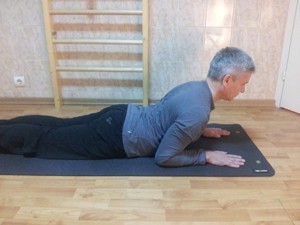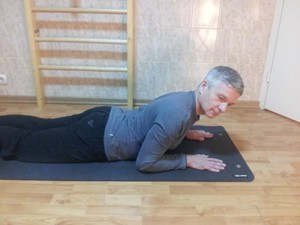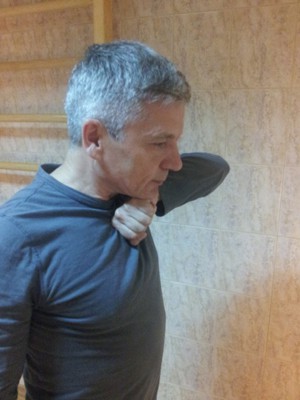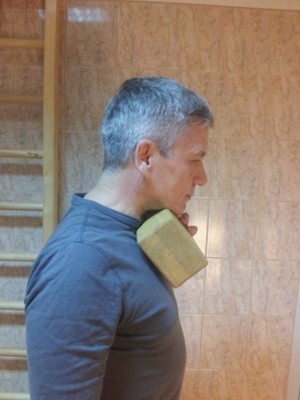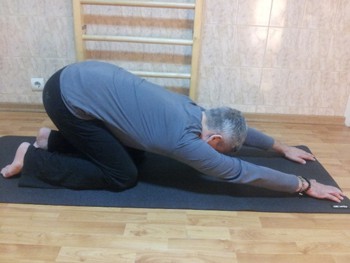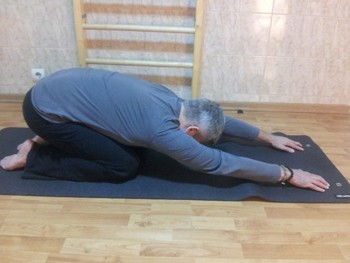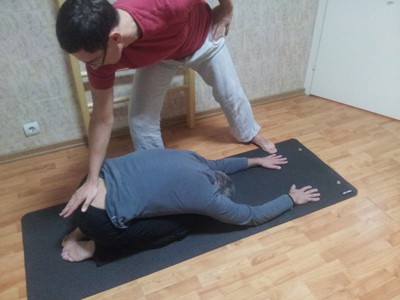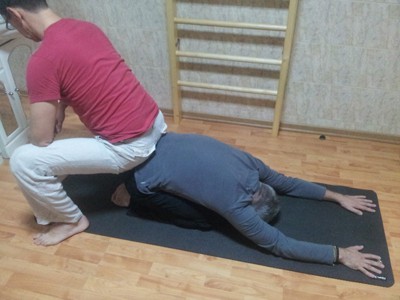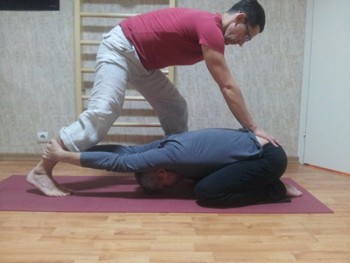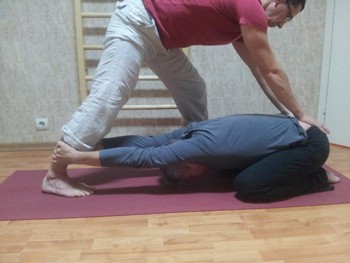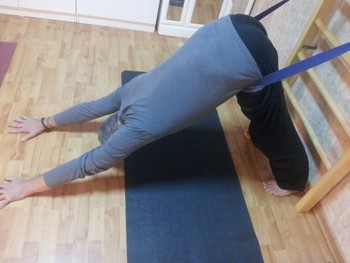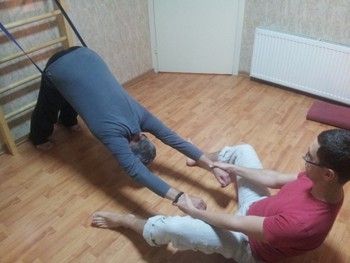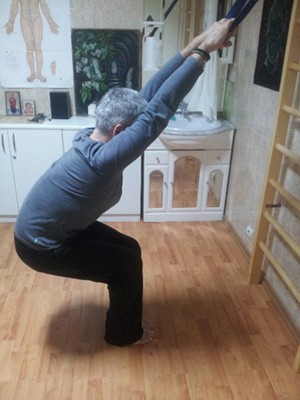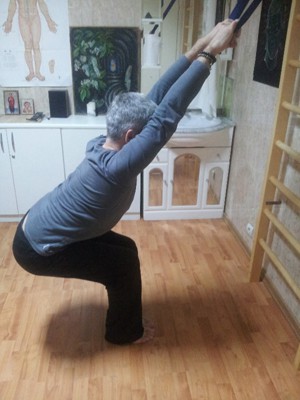Artem Frolov "Yoga therapy of the spine. Traction techniques."
Traction techniques play an important role in yoga therapy of spine disorders, especially of intervertebral herniation. The term of “traction” means the process of stretching or impacting the spine (or a separate segment of musculoskeletal apparatus) by means of two forces acting in opposite directions. Those forces can be: a force of gravity, muscular force of the patient or an external force (additional weight or assistant’s help). Traction results in a decrease of pressure in intervertebral disks, an increase of diameter of intraspinal holes where nervous roots pass, a stretching of muscles and ligaments of the spine.
It should be understood that a commonly used term “stretching”, popular now in yoga environment, not always means the real traction. For example, so called stretching of the vertebral column in tadasana does not have anything common with the traction; asana alignment, pulling up the crown of the head can improve the overall configuration and geometry of the spine and the degree of its physiological bends. But the weight of the head still provides pressure to the cervical spine and shoulder girdle; the head and the neck – to thoracic spine; all the mentioned plus thorax – to the lumbar spine. The spine continues to experience the natural load; mechanical stretching does not take place that is why this technique is not traction.
Real stretching or traction has a favorable influence in cases pathology of intervertebral disks’ pathology. There are many reports on reposition of nucleus pulposus by means of stretching (J.Matews, 1972, R.Gupta, S.Ramarad, 1978 and others). Increasing the force that stretches the spine (or increasing the weight of the load) a proportional decrease of intervertebral pressure occurs. This process continues until the weight of the load does not exceed 17-20 kg; a greater weight leads to a reflector generalized tension of the spinal muscles (Y.U.Popelyansky).
Computer tomography control displays the reduction of hernia protrusion in 2-2.5 times among one half of the patients who have been exposed to traction, and decrease of spine edema.
A research that compares two groups of patients with chronic pains in lumbar spine shows that the group that used exercises, physiotherapeutic treatment and tractions got better results than the other group that only used exercises and physiotherapy (Diab A.A., Moustafa I.M., 2013).
The effect of treatment by means of traction is worse in cases of sequestered herniation (Tsivyan Y.L., 1975). It is logical as sequestered disk which has lost its structural connection with the main pulpous nucleus cannot be “placed back” into the intervertebral space during traction.
According to Y.U.Popelyansky, “…radicular pains eliminate among the many patients right after the traction begins… Neck and lumbar pains often disappear due to traction which is obviously connected with a reduced pressure of herniation to the posterior longitudinal ligament.
Mechanisms of traction
Three types of traction can be distinguished. The first is mechanical; logically the most obvious, this variant is studied better than the others and has its experimental confirmation (see above). Stretching of the spinal segment increases the distance between vertebral bodies and thus lowers intervertebral pressure, increases the gradient between the herniation and the main part of the intervertebral disk, that contributes to the retraction of the prolapsed part of the nucleous pulposus; the height of intervertebral space and diameter of vertebral hole increase thus lowering the pressure on the nerve root.
The second type is reflectory: stretching of the spine influences mechanoreceptors of the disks, ligaments, muscules and joints which mainly determine the effects of traction (B.D.Wyke, 1975). Spine traction is not only a mechanical stretching influence but influencing receptory apparatus of the spine that changes relations between different parts of the nervous-muscular system, motor zones of the spinal cord and brain, regulation of perepherical blood circulation and muscular tone.
The third type suggests influencing intervertebral ligaments. Joint capsules have inner layers – meniscoids. From inside joint cavity is covered by a so called hondrosinovial gelatin membrane, thin and slippery. In its honeycombs, similar to a sponge, it contains synovial liquid (J.Kos, 1968, H.A.Chudnovsky, R.L.Zaitseva, 1986). At polioartritis this membrane is being damaged first before the damage of the cartilage. At osteohondrosis there can be a displacement of meniscoid into the joint cavity, or its distortion, sequestration and infringement of the fragment between the joint cartilages; it leads to joint blocking and mobility disorder (K.Levit, 1973). Traction can contribute to a normal reposition of meniscoid; it leads to a temporary elimination of pain or a prolonged remission (Yung D., Bavermeister H., 1984).
Thus a clinical improvement while using traction techniques can be caused by a mechanical stretching influence on spine structures, reflectory influence on receptors of the muscles and ligaments as well as improving the state (deblocking) of intervertebral joints.
Traction in yoga practice at home
In modern vertebrology tractions are usually fulfilled with the help of special means – traction tables, hang ups, traction in water in a special tank and others. Yoga theraphy is oriented to a self-assistance with a minimum usage of special means. Here we will describe yogic techniques that can be done by anyone at home.
Ardha bhujangasana
Ardha bhujangasana (a half a cobra pose) – traction of the thoratic and lumbar spine (picture 1).Lay down, bend your arms and place forearms on the floor parallel to each other. Elbows are on the floor right under the shoulders or a little bit closer to the pelvis. In this position there is almost no bend and the spine forms a flat ark starting from the sacrum and up to the top of the head (do not lower or tilt the head back, it should be a continuation of one straight line with the spine). From this position fulfill pulling movements with the hands as if you are trying to “pull in” the floor behind you. Shoulders softly move forward; the spine stretches forward together with the shoulders. In the beginning you should fulfill a dynamic variant: soulders slowly move forward, the spine is stretching and pulls the pelvis and legs that slowly move forward following the shoulders. Having pulled your pelvis a little bit further move your hands forward and again pull the rest of the body with the help of the hands.
Repeat the sequence several times; it is better to do this exercise on a slippery floor but not on a yoga mat. Static variant is fulfilled from the same initial position: ”pulling” the floor behind you, move your shoulders forward stretching the spine between the shoulders and the pelvis, but not very strong so that the pelvis did not move and keep this stretching position for while. This variant can be accompanied by slight movements of the shoulders from side to side; the spine stays stretched (picture 2). Fulfill static variant for 1-2 minutes or make several short series.
In this traction variant the spine is stretched along the axis with the help of two opposite forces – forward movement due to the work of the shoulder muscles and gravity of the pelvis and lower extremities.
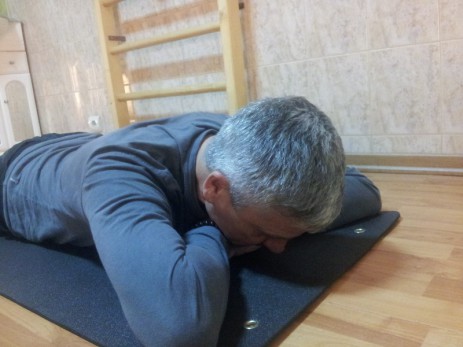
Traction of the neck in lying position
Traction of the cervical spine in lying position has an isolated influence on the neck (picture 3).
Lay down, put your hands one upon the other behind your neck, thumbs are directed to the chest. Elbows are simmetricaly head forward. Chin is placed against the palm ribs. Do not tilt the head back, if possible the crown of the head should be directed forward, the neck is parallel to the floor. Sometimes the nose touches the floor; in this case you should move your palms further for 1-2 santimeters. Here the chin is the bearing; slightly strengthen your nodding muscles (sternocleidomastoid muscles) and press the chin against the palm ribs, relaxing and stretching the back part of the neck. Relax face muscles, breath is normal. Stay in this position for 20-60 seconds.
After the described variant (static) fulfill a dynamic variant: softly pressing palm ribs with the chin roll your head from one side to the other. Relax the back part of the neck. Make rolling movements with the head for 2-3 minutes.
In this traction the stretching force is the gravity of the head and the work of the nodding muscles of the neck acting in one direction and gravity of the chest and the whole body in the other.
Traction of the cervical spine
Traction of the cervical spine can also be done in sitting or standing position by means of the chin pressing against the fist placed between the chin and the breast bone (Y.U.Popelyanski, 1997). Instead of the fist you can use a soft block (picture 4 and 5).
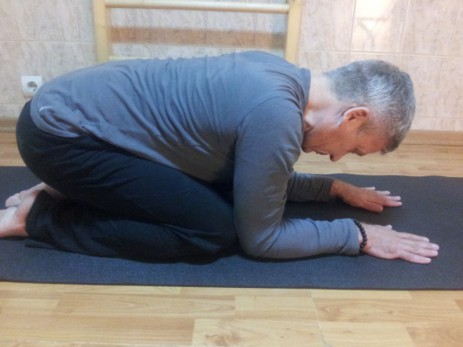
Traction of the cervical and lumbar spine in modification of majariasana
Stand on your knees and elbows, elbows contact the knees (picture 6). The spine is staright, without curves or bends. Head is not lowered or tilted back, the neck and the head are the continuation of one staright line with the spine. From this position slowly move your torso alternately forwad and backward; stretching forward with the crown of the head and backward with tailbone; hands and legs are constantly tensed, the spine is stretching between the cervical part and the pelvis. Movement is slow, almost imperceptible, done with constant self-resistance.
Dynamic variant of adho mukha virasana
Stay in adho mukha virasana (shashankasana, ardha kurmasana): the knees, shins and feet are on the floor, pelvis is on the heels, the knees are slightly apart, arms are slightly bent in elbows, a forehead and forearms are on the floor. In cases when the pelvis can not be put down on the heels (stiffness of hip and knee joints) place a bolster or a blanket between the buttocks and the ankles; if the forehead cannot reach the floor place a small pillow. With inhalation raise the pelvis over the heels (for 20-30 santimeters), move forward the fingers of the hands (picture 7); with exhalation put the pelvis down very slowly into initial position, the fingers of the hands are “grasping” the floor and move slowly creating a resistance to the body’s movement (picture 8). The spine is stretching between the cervical part and the pelvis. Repeat the sequence for 10-12 times.
Effectiveness of some traction techniques can be increased due to an assistant’s (yoga therapist) support:
Traction with kyphosis exercises for lumbar spine in adho mukha virasana
Initial position – adho mukha virasana (see description above).
There are several stages in this traction technique which consider gradual change of the intensiveness of the impact. The first stage: assistant using his palm softly (!) presses against the lower part of the sacrum, thus lumbar part is being kyphosed (picture 9).
The second stage: assistant provides similar influence accurately sitting down on the lower part of the sacrum of the patient; he should not do it using the whole weight of his body but carefully dosing the degree of the influence keeping his legs strained (picture 10).
The first and the second stages generally influence kyphosis of the lower back. The third stage is the traction together with kyphosis influence. A patient crosses his fingers and keeps his hands on a lower part of the assistant’s leg close to the ankle; the arms of the patient should be straightened in elbows. The assistant keeps his right leg straight; heel is raised over the floor. Left leg is put forward and bent in knee. Assistant places bases of his palms on the lower part of the patient’s sacrum. Patient makes a deep inhalation and a prolonged exhalation (better to use ujjai breathing), during exhalation assistant softly presses against the sacrum, lowering the right heel to the floor (pictures 11 and 12). The spine of the patient is stretching between two points - the sacrum (fixed by assistant’s hands) and cervical spine (which is stretched due to the movement of the assistant’s right heel). In this case traction is combined together with kyphosis influence on the lower back.
If you have wall bars (or hooks in the wall) you can use the following variants of traction:
Traction variant of adho mukha shvanasana using a belt
You will need a belt tied to a wall bar at the height of the door handle, or tied to a hook in the wall on the same level. The belt is placed across the pelvis at the groin level; the heels of the patient are on the floor setting against the wall. If possible, straighten your legs in the knees or bend them just a little bit. Extend your arms in front of you as far as possible; relax your neck. The spine undergoes a traction effect due to the gravity of the body (picture 13). Stay in the position for 1-3 minutes.
If you have an assistant he can increase a traction effect softly pulling the patient for his arms (picture 14); the patient should relax completely.
Traction variant of utkatasana
You will need a long belt fixed to the upper wall bar (or a hook of the same height). Put yor feet together, bend your legs in knees and hip joints; straighten your arms and grasp the belt, the arms and your torso down to the pelvis form one straight line continuing a line of the belt. Knees are over the feet or a bit forward. The pelvis is hanging down and stretching the spine. Dynamic movements of the pelvis along the hip joint axis add to the traction effect: sacrum moves forward (kyphosis in the lowerback, picture 15), then backwards and upwards (lordosis in the lowerback, picture 16). Effect of the influence on the lowerback depends on lordosis’ degree in each case and tasks of yoga therapy.
In this technique traction of lumbar and cervical parts of the spine happens due to the gravity of the body of the patient. There is also a possibility to combine stretching and correction of the lowerback lordosis.
Traction effect and its degree depend on the activity of mucles-rectifiers of the spine and small paravertebral muscles (interspinal, intertransverse and others). Work of these groups of the muscles reduces the distance between the vertebras, which become fixed against each other and thus descrease the possibility to stretch the spine (i.e. as some specialists consider, traction becomes less effective). From the examples above, work of these groups of muscles takes place, first of all, in adho mukha shvanasana or utkatasana. Complete relaxation of the spinal muscles can be achieved in ardha bhujangasana and adho mukha virasana done with an assistant. Clearness in this question may only be gained with the help of objective researches. In any case, while choosing and fulfilling any variants of traction the main emphasis should be made on a complete relaxation of the spinal muscles.
In the described examples the lowerback traction was combined with kyphosis exercises. Some techniques consider spinal traction combined with lordosis exercises for lowerback (baddha-konasana in hanging position using the belt). It is supposed that this variant suits better in cases of intervertebral herniation together with a decreased lordosis (“flat lowerback”). But practical experience of using traction in combination with lordosis exercises for lowerback may clinically worsen the situation. Besides, some authoritative sources (Dubnov B.L., 1967, Popelyansky Y.U., 1997) say that tractions are not desired in any positions of spine unbending. Most of the authors mark the appropriateness of stretching in a pose common for a patient or in a pose of a slight kyphosis in the lowerback (Krasnyansky Y.I., 1967, Kaptelin A.F., 1972, Buldakova G.E. and others, 1973).
Choosing the regime of traction can also be interesting: continous stretching or dynamic interrupted, characterized by a slight change of the traction force, regular decreasing and increasing of the impact. Some data make us think that the second variant (interrupted dynamic impact) is more favorable. Meaning that during the whole time of traction you should softly and cyclically change the degree of stretching, decreasing and increasing it. You can make these changes either in one rhythm with the patient’s breathing (increasing during the inhalation and releasing during the exhalation) or use longer cycles. In general “the most expedient are short and local tractions targeted at a certain part of the spinal column” (Y.U.Popelyansky).
Force of the traction requires a thorough and accurate application. In vertebrological clinics traction is fulfilled by means of special equipment that allows to measure force of stretching with accuracy up to one kilo. Yoga therapy does not have such possibilities; that is why you should start from the minimum exposure, gradually increasing the stretching degree; the main criteria here would be the feeling of the patient before and after the traction. Time of the exposure should also be increased gradually, from one session to the other, starting from 30-60 seconds and going up to 4-5 minutes.
Accuracy and prudence are necessary because traction may lead to negative results. Excessive impact (for example, hanging on a chin-up bar where the spine gets too much weight) may cause a reflectory spasm of paravertebral muscles, increase of nerve root compression and pains. Besides, as practice shows, in a small percentage of cases such negative reactions may be caused by very slight tractions. Sometimes pain increases in the beginning of the traction that can be explained by an acute spastic reaction of the mucles of the lumbar spine; this does not require an immediate refuse from the traction therapy but requires more accurate increase of the impact, and which is very important – a preliminary preparation of the spine muscles (Y.U.Popelyansky); in yoga therapy this preparation would be a dynamic practice. That is why traction should be done in the end of yogic therapeutic complex.
A great number of authors give positive evaluation of therapeutic effectiveness of various types of stretching, they report a high procentage of improvements 67-98% (O.Troisier (1962), P.Ravault, E.Maitrepierre (1960), M.A.Farber (1970) and others). But among a certain group of patients (4%) traction techniques gave negative results. The worst results happened in cases of sequested herniation.
A step-by-step implementation of traction techniques and soft increase of the impact help to avoid negative results. It goes without saying, that an important aspect here will be considering contraindications.
Contraindications for traction tecniques
1) Hemangiomas vertebrae. These benigh tumors nowdays are often discovered by MRI studies, usually they have no symptoms. But in some cases hemangiomas lead to a number of serious disfunctions of the spine column and spinal cord. There is an evidence that one patient with hemangioma of lumbar spine has got paraplegia (paralysis of the lower extremities) in a result of the traction therapia (Tsivyan Y.L., 1975).
2) Sequestered intervertebral herniations (traction may cause a further displacement of the sequester and worsen symptoms);
3) Structural scoliosis;
4) Compression of the cauda equina;
There are complaints which are the signals to interrupt traction (R.Barbor, M.Camb): first of all, increase of pain in the beginning of stretching (considering that it happens due to sequester dispalacement); the second, increase of pain at the moment of interrupting the traction (squizze of hernia at the moment of vertebra convergence); the third, arise of pain during the traction that irradiates into the leg (hernia displacement in the direction of the nervous root).



